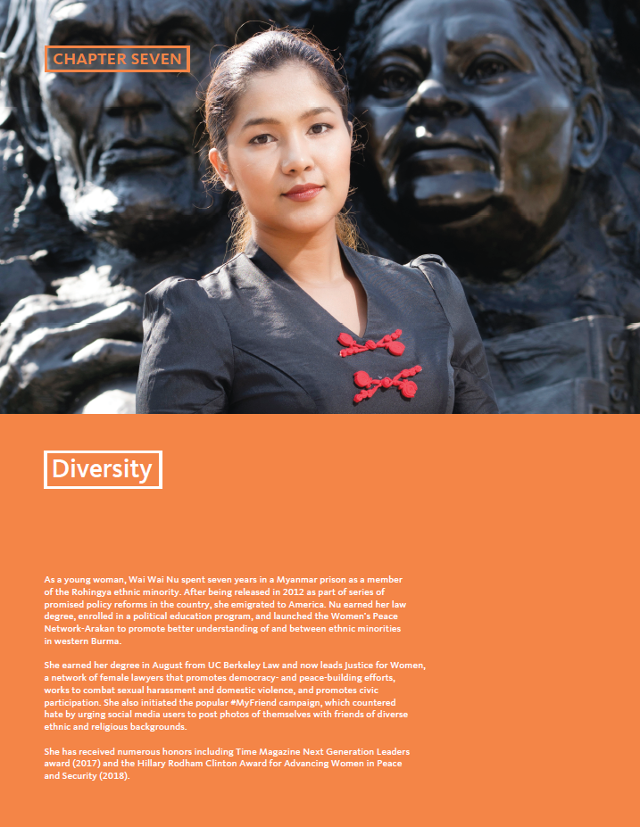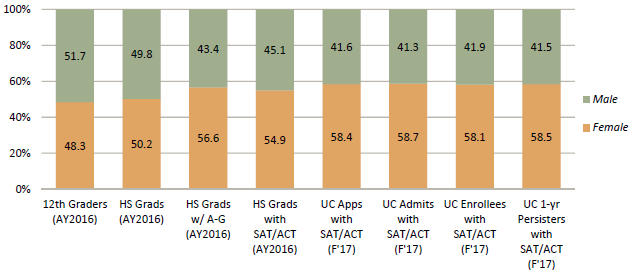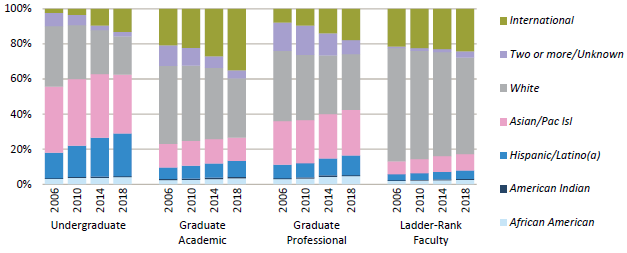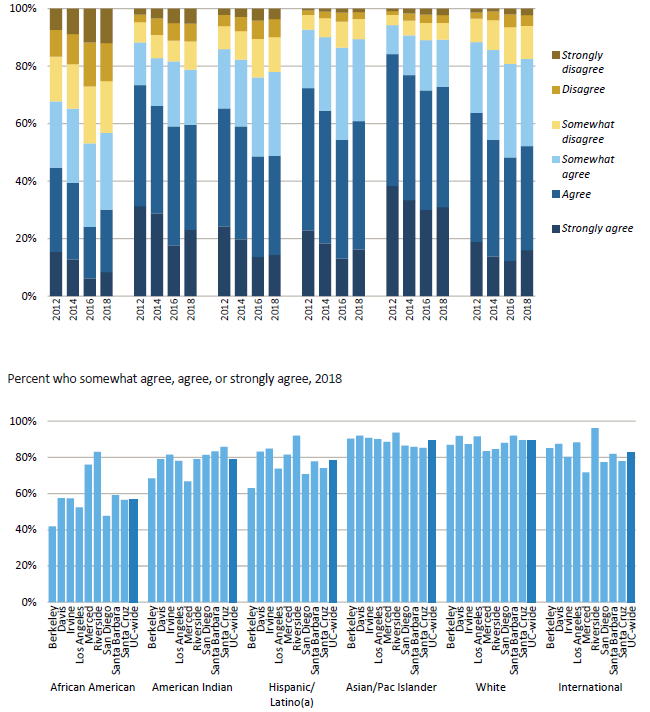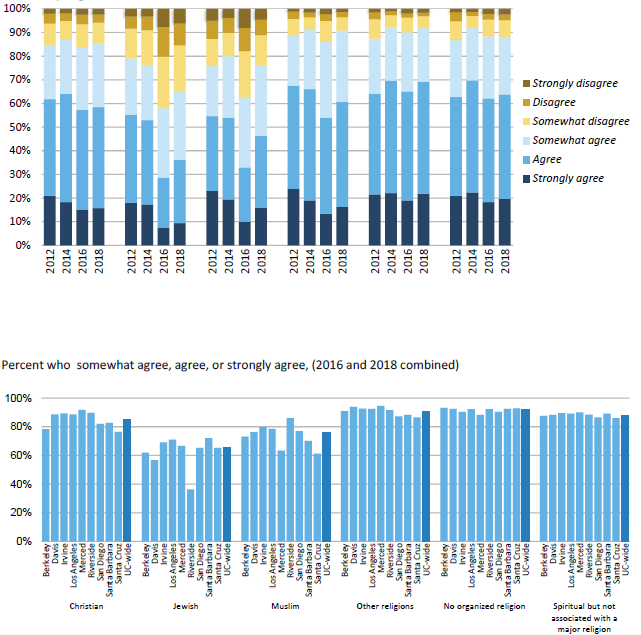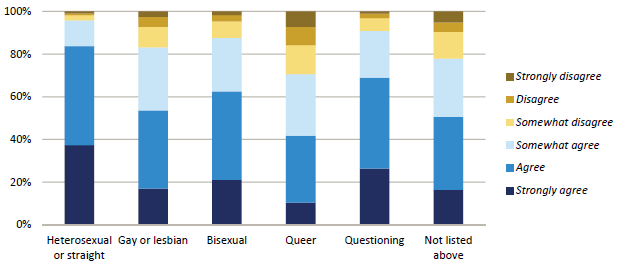chapter spotlight
As a young woman, Wai Wai Nu spent seven years in a Myanmar prison as a member of the Rohingya ethnic minority. After being released in 2012 as part of series of promised policy reforms in the country, she emigrated to America. Nu earned her law degree, enrolled in a political education program and launched the Women’s Peace Network-Arakan to promote better understanding of and between ethnic minorities in western Burma.
She earned her degree in August from Berkeley Law and now leads Justice for Women, a network of female lawyers that promotes democracy- and peace-building efforts, works to combat sexual harassment and domestic violence, and promotes civic participation. She also initiated the popular #MyFriend campaign, which countered hate by urging social media users to post photos of themselves with friends of diverse ethnic and religious backgrounds.
She has received numerous honors including Time Magazine Next Generation Leaders award (2017) and the Hillary Rodham Clinton Award for Advancing Women In Peace And Security (2018).
Goals
The University of California strives to create diverse, equitable, and inclusive communities for students, faculty, and staff. The University aspires to achieve this goal by supporting initiatives that foster an inclusive living, learning and working environment.
The University’s diversity goals are established in Regents Policy 4440: University of California Diversity Statement, which states, in part:
- Because the core mission of the University of California is to serve the interests of the State of California, it must seek to achieve diversity among its student bodies and among its employees.
- The State of California has a compelling interest in making sure that people from all backgrounds perceive that access to the University is possible for talented students, staff, and faculty from all groups.
- Therefore, the University of California renews its commitment to the full realization of its historic promise to recognize and nurture merit, talent, and achievement by supporting diversity and equal opportunity in its education, services, and administration, as well as research and creative activity.
- The University particularly acknowledges the acute need to remove barriers to the recruitment, retention, and advancement of talented students, faculty, and staff from historically excluded populations who are currently underrepresented.
Findings
UC is making progress in several key areas related to diversity, equity, and inclusion. These include:
- An increase in the percentage of African American and Hispanic/Latino(a) undergraduate enrollment.
- An increase in transfer admittance and enrollment for all main domestic racial/ethnic groups.
- Increasing proportions of female ladder-rank faculty across all discipline groups and a slight increase in the percentage of Hispanic/Latino(a) ladder-rank faculty.
- An increase in people from underrepresented groups (URGs) admitted to doctoral programs, particularly in physical sciences/math and life sciences.
- An increase in the number of Hispanic/Latino(a) career staff at UC campuses and UC Health, especially among managers and senior professionals (MSP).
At the same time, there are challenges and areas in which progress needs to be made. These include:
- Enrollment rates are low for African American and American Indian undergraduates, compared to the actual admission rate.
- Undergraduate African American students are less likely than other groups to agree that their race/ethnicity is respected on campus.
- A graduation gap persists between underrepresented undergraduates and White and Asian undergraduates (presented in Chapter 3 of this report).
- The proportion of women and underrepresented faculty is low, compared to availability pools in most disciplines (presented in Chapter 5).
- Senior Management (SMG) is significantly lacking in racial/ethnic diversity.
Evaluating Diversity
UC evaluates its diversity outcomes in a variety of ways: current demographic characteristics and trends of its students, faculty, and staff; analysis of the academic pipeline from entry to exit; and survey data that reveal perceptions of campus climate and respect.
Chapters 1 through 6 present an overview of trends for undergraduate, graduate academic and graduate professional students, faculty, and staff. This feeds into an overview of the University by race/ethnicity and gender.
As shown in indicator 7.3.1, trend data illustrate growing proportions of underrepresented and international students in the undergraduate population. Over the last 15 years, the proportion of Hispanic/Latino(a) undergraduates has grown tremendously, reflecting both the growing number of Hispanic/Latino(a) students in California and improvements in high school graduation rates. Five UC campuses (Irvine, Merced, Riverside, Santa Barbara, and Santa Cruz) are designated by the federal government as Hispanic-Serving Institutions (HSIs). A sixth institution, UC Davis, has met the requirements to be eligible for HSI designation status, and UCLA and UC San Diego have seen significant growth in their Hispanic student populations, and UC Berkeley has a goal to become an HSI as well.
Chapter 4, indicator 4.1.2, shows that among graduate academic students, underrepresented populations display steady increases across disciplines, with growth in international students, primarily in physical science and engineering. Women are the majority in all disciplines except for physical science and engineering. Graduate professional degree programs show similar patterns for underrepresented and international students, with variation by discipline. Education programs have a larger proportion of underrepresented students, and business and other professional degree programs have growing international populations. The proportion of women in graduate professional degree programs is around 50 percent or higher for all disciplines except business and engineering.
The proportion of women and underrepresented groups in the faculty continues to grow at a modest pace. Compared with ladder-rank faculty, many other academic positions are more ethnically diverse and gender-balanced because they experience more rapid turnover. Still, comparing UC’s faculty diversity with peer research institutions, UC places second in terms of female faculty and in terms of faculty from URGs (5.2.3).
For staff, the proportions of nonwhite and female managers and senior professional (MSP) and senior management group (SMG) positions are smaller than their proportions in professional and support staff (PSS) positions. The proportion of women among ladder-rank faculty is lower than proportions among other academic employees, as shown in Chapter 5.
Pipeline
UC diversity outcomes are also assessed by examining the various steps along the academic pipeline.
In the undergraduate pipeline from high school graduation to the end of the first year at UC, about six in ten California public high school twelfth-graders come from historically underrepresented groups. However, only less than four in ten of these twelfth-graders who enrolled in UC and persisted past their first year came from underrepresented ethnic groups. This is a strong indication that UC is not keeping pace with the diversity of California high school graduates.
Surveying Students about Diversity on Campus
This chapter presents responses to the UC Undergraduate Experience Survey (UCUES), administered every two years to all undergraduates. The University’s goal is to have all its students feel respected on campus, regardless of race/ethnicity, religious affiliation, gender identity, gender expression, sexual orientation, or political beliefs.
University of California Undergraduate Experience Survey (UCUES) data show most undergraduates feel students of their race/ethnicity are respected on campus, but the proportion of African American respondents sharing this perspective is lower than other groups. Among religious identifications, Muslim and Jewish students are less likely to feel respected. LGBTQ+ students are also less likely to feel respected, as are students identifying as conservative politically.
Looking Forward — Diversity Initiatives
UC has made considerable investments in 2018 and 2019 to diversify the faculty, staff, and senior leadership. It has also created meaningful opportunities for historically underrepresented populations to be fully recognized and build inclusive communities.
In the 2017 Budget Act, the State allocated $2 million to the University of California in one-time funding to support equal opportunity in faculty employment. UC’s budget from the State for 2018–19 included another year of $2 million in funding, which was matched by an additional commitment of $454,000 from President Napolitano. Ten campus proposals have been funded. These include four faculty recruitment pilots (Life Sciences at UC Berkeley; campus-level at UC Davis; Schools of Natural Sciences and Engineering at UC Merced; and the Department of Math at UC Riverside) and six retention/climate pilots (School of Public Health at UC Berkeley; STEM schools at UC Irvine; College of Humanities, Arts, and Social Sciences at UC Riverside; Division of Arts and Humanities at UC San Diego; Departments of Engineering and Physics at UC Santa Barbara; and campus-level at UC Santa Cruz). These initiatives will enable campus-level departments and disciplines to continue investing in programs and practices that yield and retain a diverse and talented professoriate.
Two systemwide convenings were held to focus on the infrastructure, capital, and staffing needed as more UC campuses move toward becoming HSIs. The UC Chicano(a)/Latino(a) Leadership Summit brought together campus teams of faculty, staff, administrators, and graduate students to network, to gain a greater understanding of Chicano(a)/Latino(a) representation at UC, and to help develop strategies for engaging UC’s next generation of leaders. The Summit was followed by the Hispanic-Serving Institution Retreat, where campus teams learned from current HSI campus representatives and national HSI scholars about attributes of model HSIs.
2018 and 2019 also marked the passage and implementation of the Gender Recognition Act (California Senate Bill 179). The bill streamlines the process for Californians to change their gender designations on state documents and creates a new nonbinary gender code option (the letter “X” or “NB”) on California birth certificates, driver licenses, identity cards, and gender-change court orders. This enables gender minority populations (e.g., transgender, intersex, and nonbinary people) to have fuller recognition in California.
To honor the spirit of the Gender Recognition Act, Systemwide Human Resources has updated the University’s new systemwide payroll system (UCPath) to provide employees the opportunity to self-identify as a nonbinary gender. Changes to student data systems are also being studied.
For more information

